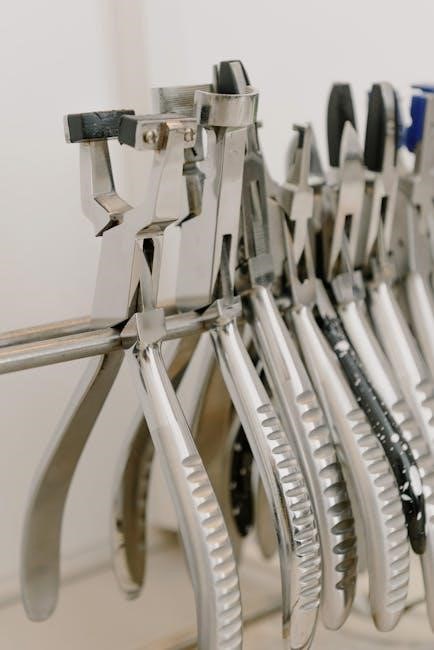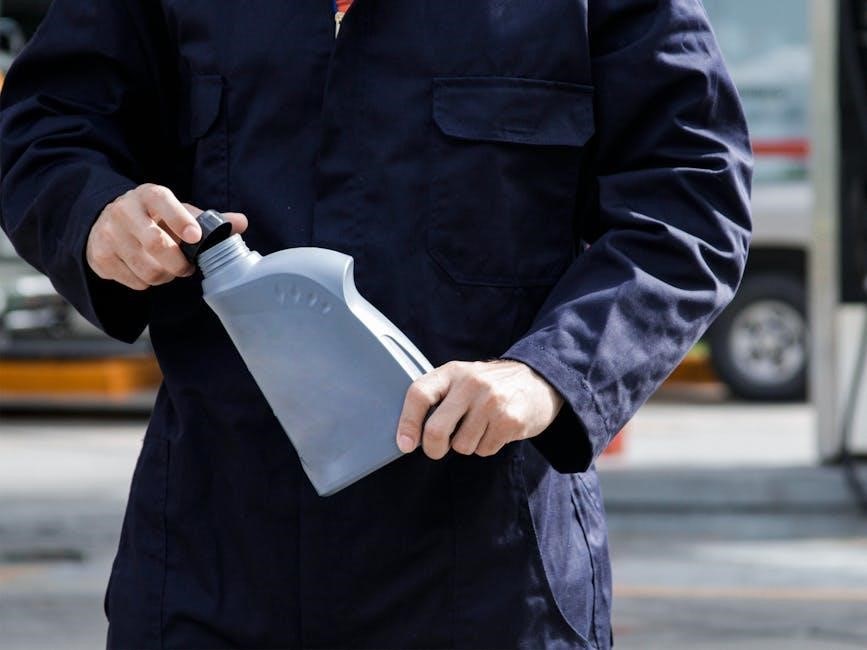The 2003 Harley-Davidson Service Manual is a comprehensive guide for maintaining and repairing various models, including Softail, Touring, Dyna, and Sportster. It provides detailed instructions, wiring diagrams, and essential specifications to ensure proper servicing, helping owners and mechanics maintain performance and safety. This manual is a must-have resource for DIY enthusiasts and professionals alike, covering everything from routine maintenance to complex repairs.
Overview of the Manual
The 2003 Harley-Davidson Service Manual is a detailed guide designed to help users maintain, repair, and customize their motorcycles. It covers models like Softail, Touring, Dyna, and Sportster, providing step-by-step instructions, wiring diagrams, and essential specifications. The manual is organized into sections such as maintenance, chassis, engine, and electrical systems, making it easy to navigate. Whether you’re a DIY enthusiast or a professional mechanic, this resource ensures proper servicing, maintaining performance, and adhering to safety standards. It’s a must-have for anyone looking to keep their Harley-Davidson in prime condition.
Importance of the Service Manual for Maintenance and Repair
The 2003 Harley-Davidson Service Manual is essential for ensuring proper maintenance and repair of your motorcycle. It provides detailed instructions, specifications, and diagrams to help users perform tasks safely and effectively. By following the manual, owners can prevent costly mistakes, maintain their bike’s performance, and ensure compliance with manufacturer standards. Whether you’re a DIY enthusiast or a professional mechanic, this guide is indispensable for keeping your Harley-Davidson in optimal condition and extending its lifespan. It’s a critical resource for anyone looking to uphold safety, reliability, and peak functionality.

Models Covered in the 2003 Harley-Davidson Service Manual
The 2003 service manual covers Softail, Touring, Dyna, and Sportster models, providing detailed repair and maintenance guidance for each lineup.
Softail Models
The 2003 Harley-Davidson Service Manual includes detailed coverage for Softail models, offering step-by-step instructions and high-resolution wiring diagrams. It ensures optimal maintenance and repair, covering the FXSTDSE and other Softail variants. The manual is bookmarked and linked for easy navigation, making complex procedures accessible for both professionals and DIY enthusiasts. This resource is essential for preserving the performance and longevity of 2003 Softail motorcycles, providing comprehensive guidance on everything from routine servicing to advanced diagnostics and repairs.
Touring Models
The 2003 Harley-Davidson Service Manual extensively covers Touring models, providing detailed procedures for maintenance, diagnostics, and repairs. It includes sections on fuel systems, electrical diagnostics, and transmission servicing, ensuring optimal performance. High-resolution wiring diagrams and specifications are provided for accurate troubleshooting; This manual is indispensable for Touring model owners, offering comprehensive guidance to maintain safety and reliability. Whether addressing routine maintenance or complex repairs, the manual empowers users with precise information to keep their motorcycles in peak condition.
Dyna Models
The 2003 Harley-Davidson Service Manual includes detailed coverage for Dyna models, offering step-by-step repair and maintenance instructions. It addresses engine overhaul, transmission servicing, and electrical system diagnostics, ensuring accurate troubleshooting. The manual provides specifications, wiring diagrams, and maintenance schedules tailored for Dyna models. This resource is essential for both professionals and DIY enthusiasts, enabling them to perform repairs efficiently. By adhering to the manual’s guidelines, users can maintain their Dyna motorcycles’ performance, safety, and reliability with confidence and precision.
Sportster Models
The 2003 Harley-Davidson Service Manual offers extensive coverage for Sportster models, including the 883 and 1200 variants. It provides detailed procedures for maintenance, tune-ups, and repairs, ensuring optimal performance. The manual includes wiring diagrams, troubleshooting guides, and specifications specific to Sportster models. Whether addressing engine issues, transmission maintenance, or electrical diagnostics, this resource empowers users to service their bikes effectively. It serves as an indispensable guide for both novice and experienced mechanics, fostering a deeper understanding of Sportster mechanics and enhancing overall riding experience.

Downloading the 2003 Harley-Davidson Service Manual PDF
The 2003 Harley-Davidson Service Manual PDF is available for free download from various online sources, offering detailed repair and maintenance instructions for all models.
Free Download Options
The 2003 Harley-Davidson Service Manual PDF can be downloaded for free from various online platforms. Websites like CarManualsOnline.info and Harley-Davidson enthusiast forums offer direct links to the manual. Additionally, some motorcycle repair communities and repositories provide free access to the PDF. These manuals are often comprehensive, covering models such as Softail, Touring, Dyna, and Sportster. They include detailed wiring diagrams, maintenance schedules, and repair procedures. Users can search for “2003 Harley-Davidson Service Manual PDF free download” to find reliable sources. Ensure to verify the authenticity of the source to avoid malicious files.
Sources for the Manual
The 2003 Harley-Davidson Service Manual PDF can be sourced from various online platforms. Websites like CarManualsOnline.info and Harley-Davidson enthusiast forums offer free downloads. Additionally, motorcycle repair communities and repositories provide access to the manual. These sources often include comprehensive guides for models like Softail, Touring, Dyna, and Sportster. They typically offer detailed wiring diagrams, maintenance schedules, and repair procedures. Users can also find scanned versions of the manual on dedicated Harley-Davidson service manual download pages. Always verify the authenticity of the source to ensure a safe download.

Understanding the Content of the Service Manual
The 2003 Harley-Davidson Service Manual is an essential resource for maintenance, repairs, and diagnostics. It covers engine, chassis, fuel system, and electrical components, supported by wiring diagrams.
Maintenance and Lubrication
Maintenance and lubrication are critical for extending the life of your 2003 Harley-Davidson. The manual provides detailed schedules and procedures for oil changes, filter replacements, and lubrication points. It outlines recommended lubricants and frequencies to ensure optimal performance and longevity. Regular maintenance checks are emphasized to prevent wear and tear. Step-by-step instructions guide users through essential tasks, while torque specifications are included for precise adjustments. This section is vital for riders aiming to keep their bike in prime condition and avoid costly repairs. Proper lubrication ensures smooth operation and protects critical components.
- Oil change intervals and filter replacement guidelines.
- Lubrication points for chains, hinges, and other moving parts.
- Recommended lubricants and greases for specific applications.
- Torque specifications for bolts and fasteners.
By following the manual’s maintenance and lubrication recommendations, riders can ensure their Harley-Davidson runs efficiently and reliably for years to come.
Chassis and Suspension
The 2003 Harley-Davidson Service Manual provides detailed guidance on chassis and suspension maintenance. It covers frame inspection, fork alignment, and shock absorber service. Procedures for adjusting suspension components ensure optimal handling and ride comfort. The manual also includes troubleshooting tips for common issues like uneven tire wear or poor stability. Proper torque specifications for chassis bolts are provided to maintain structural integrity. Regular inspection of suspension parts is emphasized to prevent failure and ensure safety. This section is essential for maintaining the bike’s stability and responsiveness on the road.
- Frame and swingarm inspection procedures.
- Fork and shock absorber maintenance.
- Tire pressure and alignment specifications.
- Troubleshooting suspension-related issues.
Engine and Transmission
The 2003 Harley-Davidson Service Manual details engine and transmission maintenance, including oil changes, filter replacements, and torque specifications. It provides step-by-step instructions for inspecting and servicing critical components like piston rings, cylinders, and gears. Troubleshooting guides help diagnose issues such as low compression or gear slippage. The manual emphasizes proper fluid levels and viscosity for optimal performance. Regular checks for wear on transmission parts are highlighted to prevent costly repairs. This section ensures riders maintain their bike’s power and reliability on the road.
- Oil and filter replacement procedures.
- Transmission fluid specifications.
- Piston and cylinder inspection.
- Gear and bearing maintenance.
Fuel System and Electrical Diagnostics
The 2003 Harley-Davidson Service Manual provides detailed instructions for diagnosing and servicing the fuel system, including carburetor adjustments, fuel line inspections, and vacuum tests. Electrical diagnostics cover troubleshooting techniques for circuits, fuses, and sensors. The manual includes procedures for testing the ignition system, battery charging, and wiring harness connections. Clear step-by-step guides help identify common issues like faulty spark plugs or malfunctioning sensors, ensuring optimal performance and reliability.
- Fuel system maintenance and troubleshooting.
- Electrical circuit testing procedures.
- Ignition and sensor diagnostics.
- Battery and charging system checks.

Troubleshooting Common Issues
The 2003 Harley-Davidson Service Manual offers detailed diagnostic techniques to identify and resolve common issues. It provides step-by-step solutions for engine, transmission, and electrical system problems.
- Electrical system diagnostics.
- Engine performance troubleshooting.
- Transmission and drive system repairs.
Diagnostic Techniques
The manual outlines systematic diagnostic techniques to identify issues efficiently. It covers tools and methods for troubleshooting electrical systems, engine performance, and transmission problems. Detailed wiring diagrams and step-by-step procedures guide users through tests and repairs, ensuring accurate diagnoses. By following these techniques, riders can address common issues like faulty sensors, ignition problems, or transmission slippage. The manual emphasizes safety and precision, helping users avoid costly mistakes and extend their bike’s lifespan. These methods are essential for both novice and experienced mechanics working on 2003 Harley-Davidson models.
Common Repairs and Solutions
The manual details common repairs for 2003 Harley-Davidson models, addressing frequent issues like oil leaks, ignition malfunctions, and brake wear. It provides solutions for repairing faulty sensors, addressing transmission slippage, and resolving electrical system glitches. Step-by-step guides help users fix issues such as carburetor adjustments, spark plug replacement, and tire wear. The manual also covers preventive measures, ensuring riders can identify and fix problems before they escalate. These solutions are tailored to help owners maintain their bikes’ performance, safety, and reliability, making it an indispensable resource for routine and unexpected repairs.

Maintenance Schedule and Tips
The 2003 Harley-Davidson Service Manual outlines essential maintenance schedules, including routine checks, oil changes, and tire inspections. It provides tips for seasonal preparation and proper lubrication to ensure optimal performance and extend the motorcycle’s longevity.
Scheduled Maintenance Intervals
The 2003 Harley-Davidson Service Manual provides detailed scheduled maintenance intervals to ensure optimal performance and longevity. Regular checks every 5,000 miles are recommended, including oil changes, tire pressure adjustments, and brake inspections. Additional services, such as spark plug replacement and belt tension checks, are scheduled at 10,000-mile intervals. Following these intervals helps prevent mechanical issues, ensures safety, and maintains the motorcycle’s performance. The manual also outlines specific intervals for fluid replacements, air filter cleaning, and chassis lubrication, tailored to different riding conditions and mileage accumulation.
DIY Maintenance Projects
DIY Maintenance Projects
The 2003 Harley-Davidson Service Manual empowers owners with detailed guidance for DIY maintenance projects. From oil changes to air filter replacements, the manual provides step-by-step instructions for common tasks. Riders can learn to perform routine checks, such as inspecting brake pads and lubricating moving parts. Additionally, the manual offers tips for basic repairs, like replacing spark plugs or adjusting the clutch. These projects not only save money but also foster a deeper connection with the motorcycle. With clear instructions and safety precautions, the manual makes DIY maintenance accessible to riders of all skill levels.
Electrical System and Wiring Diagrams
The 2003 Harley-Davidson Service Manual includes detailed wiring diagrams and electrical system troubleshooting guides, ensuring clarity for diagnostics and repairs. These resources aid in understanding complex circuits and components.
Understanding Wiring Diagrams
The 2003 Harley-Davidson Service Manual provides detailed wiring diagrams essential for diagnosing electrical issues. These diagrams are color-coded and labeled, making it easier to identify components and connections. They cover systems like the ignition, lighting, and accessories, allowing users to trace circuits and locate faults efficiently. Understanding these diagrams is crucial for accurate repairs, ensuring safety and proper functionality. The manual also includes a legend explaining symbols, enhancing comprehension for both novice and experienced technicians. This resource is invaluable for maintaining and repairing the motorcycle’s electrical system effectively.
Electrical System Troubleshooting
The 2003 Harley-Davidson Service Manual provides detailed guidance for troubleshooting electrical system issues. Common problems include faulty connections, blown fuses, or malfunctioning sensors. The manual outlines step-by-step procedures for diagnosing issues like dim or flickering lights, dead batteries, or faulty ignition systems. It emphasizes the use of tools like multimeters to test voltage and continuity. By following the manual’s instructions, users can identify and resolve electrical faults efficiently, ensuring optimal performance and safety. This section is crucial for maintaining the integrity of the motorcycle’s electrical components and preventing further damage. Regular checks and proper troubleshooting practices are encouraged.

Engine Specifications and Repair
The 2003 Harley-Davidson Service Manual details engine specifications, including displacement, torque, and horsepower. It provides procedures for overhauls, cylinder head repair, and tuning for optimal performance.
Engine Overhaul Procedures
The 2003 Harley-Davidson Service Manual outlines detailed engine overhaul procedures, including disassembly, inspection, and reassembly. It covers replacing piston rings, bearings, and gaskets, ensuring precise torque specifications and clearances. The manual emphasizes proper tool usage and safety precautions to prevent damage. Step-by-step instructions guide technicians through critical tasks, such as crankshaft alignment and cylinder head resurfacing. These procedures ensure the engine operates efficiently, maintaining its power and reliability. Adhering to these guidelines is crucial for a successful overhaul and longevity of the motorcycle.
Tune-Up and Performance Enhancements
The 2003 Harley-Davidson Service Manual provides detailed procedures for tune-ups and performance enhancements. It includes instructions for adjusting the air-fuel mixture, replacing spark plugs, and optimizing ignition timing. Additionally, the manual covers performance upgrades such as installing aftermarket exhaust systems, high-performance air filters, and carburetor modifications. These enhancements aim to improve power, torque, and fuel efficiency. The guide emphasizes adhering to torque specifications and manufacturer recommendations to ensure reliability and maintain warranty compliance. Proper execution of these procedures can significantly enhance the motorcycle’s overall performance and riding experience.
Transmission and Drive System
The 2003 Harley-Davidson Service Manual details transmission and drive system maintenance, including gear lubrication, belt tension adjustment, and sprocket replacement. It provides repair procedures for common issues like slipping gears or worn bearings, ensuring smooth power delivery and optimal performance. Regular servicing of these components is crucial for extending the motorcycle’s lifespan and maintaining reliability on the road.
Transmission Maintenance
The 2003 Harley-Davidson Service Manual emphasizes regular transmission maintenance to ensure smooth operation and longevity. It outlines procedures for lubricating gears, inspecting gear engagement, and adjusting belt tension. The manual also covers replacing worn components like bearings and seals. Proper lubrication with Harley-Davidson-approved oils is stressed to prevent corrosion and wear. Regular checks of the transmission case for leaks and damage are recommended. Following the manual’s guidelines helps maintain optimal performance, reduce repair costs, and extend the lifespan of the transmission system.
Drive System Repair and Replacement
The 2003 Harley-Davidson Service Manual provides detailed instructions for diagnosing and repairing the drive system. It covers inspection of the belt or chain, replacement of worn components, and alignment of the drive sprockets. The manual emphasizes precise torque specifications for bolts and fasteners to ensure reliability. Procedures for replacing the final drive unit and bearings are included, along with tips for preventing damage during disassembly. Proper tools and lubricants are recommended to maintain system integrity. Adhering to these guidelines ensures optimal performance and extends the drive system’s lifespan.

Safety Precautions and Guidelines
Always wear protective gear and ensure a stable work environment. Disconnect the battery before starting repairs to prevent electrical shocks. Avoid flammable materials near open flames or sparks. Keep loose clothing tied back and avoid jewelry that could catch on moving parts. Never work under a motorcycle unsupported by a sturdy jack stand. Follow all torque specifications and manufacturer guidelines to ensure safety and reliability during repairs. Proper ventilation is essential when working with chemicals or paints. Adhere to all warnings and cautions outlined in the manual to prevent accidents and ensure proper servicing. Regularly inspect tools and equipment for damage or wear. Keep children and pets away from the work area. Be mindful of hot surfaces and sharp edges. Properly dispose of hazardous materials like oil, coolant, and batteries. Avoid over-tightening fasteners, as this can damage components. Use jack stands rated for the weight of your motorcycle. Never smoke or use open flames near flammable liquids or gases. Ensure all electrical systems are deactivated before performing repairs. Keep a fire extinguisher nearby. Be cautious when handling sharp objects or tools. Wear safety glasses when grinding, drilling, or performing other tasks that could emit debris. Ensure proper ventilation when working with solvents or adhesives. Follow all local regulations for waste disposal. Be aware of your surroundings and avoid distractions while working. Keep emergency contact numbers accessible. Regularly review safety guidelines to stay informed and maintain a safe working environment. Always follow the manufacturer’s recommendations for safety equipment and practices. Familiarize yourself with the location of emergency shut-offs and controls. Keep a first aid kit nearby. Be prepared for unexpected situations and know how to respond. Stay alert and avoid working when fatigued. Ensure all repairs are performed on a level surface. Use proper lifting techniques to avoid injury. Keep a phone nearby in case of emergencies. Be cautious when handling heavy components and seek assistance when needed. Follow all safety labels and instructions on products used during repairs. Dispose of rags and other materials that may be soaked with flammable liquids properly. Be aware of the risks of hydraulic systems and ensure they are properly depressurized before servicing. Keep the work area clean and well-lit to prevent accidents. Avoid using damaged tools or equipment. Be cautious when working with high-pressure systems. Follow all safety guidelines for battery maintenance and charging. Be aware of the risks of working with electrical systems and ensure they are properly grounded. Keep the work area free from clutter and tripping hazards. Be cautious when handling sharp edges or pointed objects. Wear gloves when handling rough or hot surfaces. Ensure all jacks and stands are in good condition and suitable for the task. Be mindful of the weight distribution when lifting or moving the motorcycle. Follow all safety precautions when working with air compressors or other compressed air tools. Be cautious when handling chemicals and ensure proper ventilation. Wear a dust mask when sanding or grinding to avoid inhaling particles. Keep a fire extinguisher rated for chemical and electrical fires nearby. Be aware of the risks of working with fuel systems and ensure they are properly vented. Follow all safety guidelines when using power tools and equipment. Wear hearing protection when working with loud machinery. Be cautious when handling batteries and ensure they are properly secured. Keep the work area organized to prevent accidents and ensure efficiency. Follow all safety recommendations for lifting and moving heavy components. Be aware of the risks of working with suspension systems and ensure they are properly supported. Wear safety glasses when working with springs or other components under tension. Ensure all tools are properly maintained and in good working condition. Be cautious when handling brakes and ensure they are properly bled and tested. Follow all safety guidelines when working with electrical systems and avoid short circuits. Be aware of the risks of working with exhaust systems and ensure they are properly supported. Keep the work area well-ventilated when working with paints or solvents. Wear protective gloves when handling sharp or abrasive materials. Be cautious when handling fasteners and ensure they are properly tightened to specifications. Follow all safety precautions when working with the fuel system and avoid open flames. Be aware of the risks of working with high-voltage systems and ensure proper insulation. Keep emergency phone numbers accessible in case of an accident. Be cautious when handling heavy tools or equipment and ensure proper lifting techniques. Follow all safety guidelines when working with the transmission and drivetrain. Be aware of the risks of working with hydraulic brakes and ensure they are properly bled. Keep the work area clean and free from obstacles to prevent tripping. Wear protective eyewear when grinding or drilling metal. Be cautious when handling belts or chains and ensure they are properly tensioned. Follow all safety recommendations when working with the engine and transmission. Be aware of the risks of working with the cooling system and ensure proper pressure before testing. Keep a fire extinguisher nearby when working with electrical or fuel systems. Be cautious when handling sharp tools or objects and keep them away from children. Follow all safety guidelines when working with the suspension and steering systems. Be aware of the risks of working with the exhaust system and ensure proper ventilation. Keep the work area well-lit to prevent accidents and ensure visibility. Wear protective clothing when working with chemicals or hot surfaces. Be cautious when handling heavy motorcycle parts and seek assistance when needed. Follow all safety precautions when working with the braking system and ensure proper function. Be aware of the risks of working with the electrical system and avoid overloading circuits. Keep emergency exits clear and accessible in case of a fire. Be cautious when handling tools and ensure they are properly stored. Follow all safety guidelines when working with the fuel tank and ensure proper ventilation. Be aware of the risks of working with the ignition system and ensure proper grounding. Keep a first aid kit nearby and know how to use it. Be cautious when handling high-pressure hoses and ensure they are properly secured. Follow all safety recommendations when working with the cooling system and ensure proper flow. Be aware of the risks of working with the battery and ensure proper charging procedures. Keep the work area free from flammable materials and avoid open flames. Be cautious when handling sharp edges or points on metal components. Follow all safety guidelines when working with the transmission and drivetrain. Be aware of the risks of working with the suspension and ensure proper support. Keep emergency lighting available in case of power outages. Be cautious when handling heavy tools or equipment and ensure proper maintenance. Follow all safety precautions when working with the engine and ensure proper ventilation. Be aware of the risks of working with the exhaust system and ensure proper routing. Keep the work area organized to prevent accidents and improve efficiency. Be cautious when handling chemicals and ensure proper disposal. Follow all safety guidelines when working with the braking system and ensure proper function. Be aware of the risks of working with the electrical system and avoid short circuits. Keep a fire extinguisher nearby and know how to use it. Be cautious when handling sharp objects and keep them away from children. Follow all safety recommendations when working with the suspension and steering systems. Be aware of the risks of working with the fuel system and ensure proper sealing. Keep the work area well-ventilated when working with paints or solvents. Be cautious when handling heavy motorcycle parts and seek assistance when needed. Follow all safety guidelines when working with the transmission and drivetrain. Be aware of the risks of working with the cooling system and ensure proper pressure. Keep emergency phone numbers accessible in case of an accident. Be cautious when handling tools and ensure they are properly maintained; Follow all safety precautions when working with the engine and ensure proper function. Be aware of the risks of working with the exhaust system and ensure proper ventilation. Keep the work area clean and free from obstacles to prevent tripping. Be cautious when handling sharp tools or objects and keep them away from children. Follow all safety guidelines when working with the braking system and ensure proper maintenance. Be aware of the risks of working with the electrical system and avoid overloading circuits. Keep a first aid kit nearby and know how to use it. Be cautious when handling heavy tools or equipment and ensure proper lifting techniques. Follow all safety recommendations when working with the suspension and steering systems. Be aware of the risks of working with the fuel tank and ensure proper sealing. Keep the work area well-lit to prevent accidents and ensure visibility. Be cautious when handling chemicals and ensure proper ventilation. Follow all safety guidelines when working with the transmission and drivetrain. Be aware of the risks of working with the cooling system and ensure proper flow. Keep emergency exits clear and accessible in case of a fire. Be cautious when handling sharp edges or points on metal components. Follow all safety precautions when working with the engine and ensure proper function. Be aware of the risks of working with the exhaust system and ensure proper routing. Keep the work area organized to prevent accidents and improve efficiency. Be cautious when handling heavy motorcycle parts and seek assistance when needed. Follow all safety guidelines when working with the braking system and ensure proper function. Be aware of the risks of working with the electrical system and avoid short circuits. Keep a
Safe Repair Practices
Always disconnect the battery before starting repairs to prevent electrical shocks. Wear protective gear, including gloves and safety glasses, to minimize injury risks. Ensure proper ventilation when working with chemicals or paints. Never smoke or use open flames near flammable liquids. Keep the work area clean and well-lit to avoid accidents. Use jack stands rated for the motorcycle’s weight and ensure the bike is securely supported. Avoid loose clothing and jewelry that could get caught in moving parts. Follow torque specifications and manufacturer guidelines to prevent damage. Keep emergency equipment, like a fire extinguisher, nearby. Regularly inspect tools for damage and ensure they are in good working condition. Maintain a stable and level work surface to prevent accidents. Stay alert and avoid working when fatigued. Properly dispose of hazardous materials, such as oil and coolant, to protect the environment. Always refer to the manual for specific safety recommendations for your model.
Emergency Procedures
In case of an emergency, always prioritize personal safety and the integrity of the motorcycle. If a fire occurs, use a fire extinguisher rated for flammable liquids. For chemical spills, wear protective gear and neutralize the area with sand or absorbent materials. In case of electrical issues, disconnect the battery immediately to prevent further damage. Keep a first aid kit nearby and know basic first aid techniques. Ensure proper ventilation to avoid inhaling harmful fumes. Stay calm and follow the manual’s guidelines for unexpected situations. Always have emergency contact information accessible.

Accessories and Customization
The 2003 Harley-Davidson Service Manual provides guidance on installing aftermarket parts and customizing your Softail, Touring, Dyna, or Sportster. It offers tips for personalizing your bike effectively.
Installing Aftermarket Parts
Installing aftermarket parts on your 2003 Harley-Davidson requires careful planning and adherence to the service manual’s guidelines. The manual provides step-by-step instructions for upgrading components like exhaust systems, handlebars, and seats. It emphasizes the importance of compatibility and proper fitment to ensure safety and performance. Detailed illustrations and torque specifications are included to help enthusiasts achieve professional results. Always follow the manual’s recommendations to avoid potential issues and maintain your bike’s warranty and reliability. This section is invaluable for those seeking to personalize their motorcycle while keeping it in optimal condition.

Future of Service Manuals
Customization Tips and Tricks
Customizing your 2003 Harley-Davidson can enhance its appearance and performance. The service manual offers insights into modifying components while maintaining safety and functionality. Consider upgrading handlebars for better ergonomics or adding custom exhaust systems for improved sound and efficiency. Always ensure aftermarket parts are compatible with your model. Use wiring diagrams from the manual to integrate accessories like LED lights or GPS systems seamlessly. For unique touches, consult Harley-Davidson forums or enthusiast communities for inspiration. Remember, customization should balance aesthetics with performance to preserve your bike’s reliability and safety on the road.

